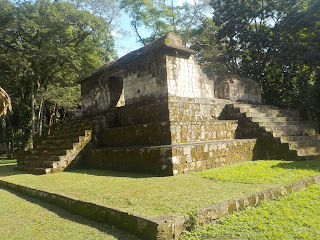 |
| Structure A-3 |
Yesterday, we made our way to Rio Pasión, a major tributary of Rio Usumacinta. Although I personally favor Rio Grijalva as the River Sidon, Usumacinta is also a leading candidate. We took a boat along the Pasión for about 2 hours, and the scenery was gorgeous! We were far from civilization, in the midst of the jungle by the time we got off the boat. From there, we hiked into the depths of the jungle until we came to Ceibal. |
| A shot from Rio Pasion |
 |
| Some of my fellow travelers, on the trail to Ceibal |
Just getting there was quite the adventure. The trail was uphill and muddy. It is a rainforest, so we did experience intermittent showers. Never in a million years did I think I would ever be tromping through the jungle like this! On the way back, the howler monkeys—which sound more like a ferocious beast that can eat you alive—were getting very close, on both sides of the trail. We couldn’t see them, but we could hear them, and it was a little terrifying.
 |
| A small part of the 3D site map |
Ceibal is a Pre-Classic and Classic site, first founded in the 9th century BC, flourishing between 400 BC–AD 200 before experiencing a collapse sometime in the early Classic, ca. AD 200–600. It recovers in the Late Classic, peaking in the 9th century AD before again experiencing a collapse (along with the rest of the Maya region). Ceibal is a fairly large site, though much of it remains unexcavated and unrestored.
 |
Mark Wright lectures with
Structure A-3 in the background |
If the Usumacinta is Sidon, then Ceibal may very well have been involved in Book of Mormon events. The dates of its Pre-Classic flourishing are squarely within the Book of Mormon timeframe, and its collapse between AD 200–600 is consistent with the Book of Mormon, which reports a decline ca. AD 200, or 4 generations after Christ’s visit, with the ultimate collapse of Nephite society coming late in the 4th century AD.
 |
Me, at the base of a large Ceiba Tree,
one of the many in the Ceibal area |
The name Ceibal was given to the site by the Spanish, because of the many Ceiba trees there at the site. The Ceiba is the largest tree in the Mesoamerican region, and was the sacred tree to the Maya and many other cultures throughout the area. While probably not the tree Lehi saw in vision, the Ceiba is probably what Alma and his audience envisioned as he discoursed on planting the seed of faith and cultivating it into the great tree of life (Alma 32).
 |
| A Ceiba Tree, actually from Tikal |
In the Maya mythos, the Ceiba, or “World Tree,” connected waters of the underworld, the earth, and the heavens. This tripartite worldview is similar to that found among the Hebrews, and expressed in Exodus 20:4, which is quoted by Abinadi in Mosiah 13:12: “Thou shalt not make unto thee any graven image, or any likeness of things which are in heaven above, or which are in the earth beneath, or which are in the water under the earth.”
From cruising along the river, to hiking in the rainforest, to seeing the ruins, it was all-in-all an incredible experience. We were able to catch the sunset on the river on our way back. A picturesque ending to an incredible day! |
| Sunset on the River |
Continue reading at the original source →



